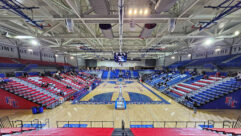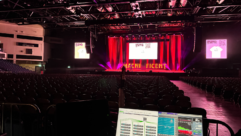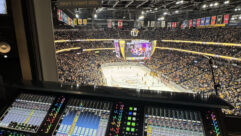Consumer market drives change in corporate arena
Nov 10, 2004 4:50 PM
The consumer market for high-end video display systems and equipment isn’t just threatening to submerge the pro AV sector in sheer numbers. It’s also fundamentally altering the relationship between integrators and their corporate clients.
Plasmas, LCD panels, and rear-projection systems are all making the jump to the mass market, where sales are exploding and prices are being driven ever downward. Sweta Dash of isuppli notes that this year, microdisplay-based television sets alone (i.e., DLP and LCD systems) should account for 1.5 million consumer units, while the corporate market will absorb less than half a million displays of all types combined.
One of the consequences is that R&D budgets, manufacturing capacity, and raw materials are increasingly being diverted from the pro segment to the consumer market. Another consequence is that consumers often have newer, better, and more exciting products at their command.
“It’s interesting how the consumer market has traded places with the pro AV market to become more cutting-edge,” says Scott Walker of Waveguide Consulting. “People today will first experience high-definition at home, before it enters the pro AV market.”
Business buyers have become “desensitized” to display questions, says industry vet Alan Brawn of Samsung. The main reason for this, he adds, is the commoditization of display technologies. “Everyone in the projector industry makes a nice little one-chip DLP projector, and at a minimum, everybody’s projector is good enough,” Brawn says. Corporate clients, he says, “just don’t get excited about a piece of technology anymore. The display now is a given.”
Instead, Brawn says the buyer’s interest has shifted – and the integrator’s strategy should shift – to applications and problem-solving.
Insight Media’s Chris Chinnock says the very familiarity of display devices to corporate buyers, coupled with the ease of price-shopping on the Internet, means these buyers often come to systems integrators with a very clear idea of not only what they want but what they should pay. “The dealer or integrator needs to educate the client and add value to the transaction,” Chinnock says.
Among possible growth paths for integrators with corporate clienteles, Dash cites digital signage, which is soaking up a growing number of plasma and LCD displays, and which stresses the kind of flexibility and networking savvy that customers can’t just buy in a store. Moreover, both Dash and Walker predict that the new generation of short-throw rear-projection DLP or LCD displays will soon command a major share of the market and give integrators another way of serving high-end customers.
Chinnock also suggests that one of the factors holding the corporate market back from fully embracing wide-format, high-definition displays is the continued domination of the meeting world by PowerPoint. Currently, he explains, corporate meeting planners may occasionally need to show a TV commercial or a video program, but most of the time, what’s on the screen is the old, familiar – and 4:3-formatted – slide show.
Walter agrees: “We’re in a painful transition from 4:3 to 16:9. The pro AV segment has had flat panels that were 16:9 and projectors that were only 4:3, and we had a problem. Now, finally we have a variety of projectors that are 16:9, but content is lagging.”
The penetration of wide-screen, high-definition video in the corporate market depends in large part on when, or if, Microsoft enhances PowerPoint to deliver 16:9 images, says Chinnock.
A spokesman for Microsoft says the company has no such plans in the pipeline.










